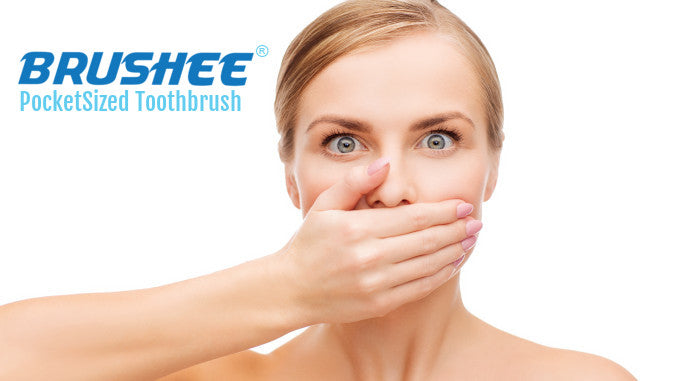![]()

How To Get Rid Of Bad Breath
Share
Posted by Brushee Brand Publisher on May 3, 2016
Lets be real.
Walking around with bad breath stinks (no pun intended).
And in fact is probably one of the worst things known to man.
Yet, millions of us do it on the daily and allow it to become a regular thing.
Don’t let this be you.
There’s no need to walk around with bad breath when you have solutions out there like the Brushee PocketSized Toothbrush.
See we created the Brushee to easily allow you to walk around with fresh breath 24/7. Our toothpaste in the bristles, toothpick, and floss allow you to have the clean you need on the go.
So don’t be the one stuck after lunch break smelling of garlic and pizza crust. Make sure you have a Brushee to maintain your freshness all day.
The Truth Behind Bad Breath (aka Halitosis)
Chronic Bad Breath
The traditional name for bad breath is actually halitosis. And to keep matters simple, there are two main categories of such, chronic and non-chronic.
Chronic bad breath could actually be the result of an underlying oral care disease or issue plaguing your mouth. So if you find yourself with a chronic issue, we recommend you schedule an appointment with your dentist to rule out any underlying oral care issues.
Conventional Bad Breath
However, if your bad breath comes from food consumption and beverages throughout the day, we’re here for you.
A majority of the problem is often when food gets stuck in the creases and crevasses of our mouth. And although mints and gum can be somewhat useful, they often do very little for long-term fresh breath.
Why Flossing For Long Term Fresh Breath Works
A toothpick and floss can in fact be just as important for freshening your breath as brushing, since they get in those hard to reach areas that may be housing the culprit of your bad breath.
One of the worst things you can do is have food stuck in your teeth, and think gum and mints are going to save the day. Sure, they may provide short-term satisfaction, but if food stuck in your teeth is actually the cause, you will soon find good ol’ Halitosis creeping back in.
And no one wants that.
When To Use a Brushee For Fresh Breath
After Meals and Snacks On-The-Go
Yes, one of the perfect times for a Brushee is after meals or snacks during the day. We know the cafeteria at school, or break room at work can have some pretty tempting items on the regular. But don’t find yourself indulging without a backup plan to keep you fresh.
Before A Meeting or Class
Only you know what kind of snacks you indulge throughout the day to keep you going. But don’t let those same delicious snacks be the ones that are causing you to cover up your mouth whenever you get close to someone. Have a Brushee on hand to help you command the fresh breath and confidence you need to bring out your best.
While Traveling
Man, it can be hard to get through TSA with all the requirements that exist. I mean it seems like nowadays you can’t bring anything with you through airport security.
That is except for a Brushee.
Brushee passes all TSA requirements, and is not only great for use in the terminals before you board the plane. But is the perfect solution for teeth cleaning while on the flight.
You could be on that plane for countless minutes or hours with bad breath or something stuck between your teeth from in flight refreshments. So let the Brushee be your solution to clean out those hard to reach areas, and keep your breath fresh the entire trip.
